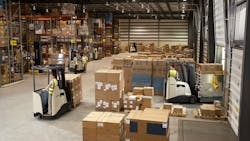Achieving Warehouse Productivity Gains Beyond the Forklift
While forklifts are vital for keeping products moving in today’s supply chains, they are not the only important pieces of the puzzle when it comes to overall warehouse productivity and efficiency. While companies need to identify opportunities to enhance the efficiency and productivity of their forklift fleets, at the same time, there may be improvement opportunities associated with other warehouse equipment that are equally impactful.
Often, these opportunities are nonconsecutive, meaning they can be addressed in no particular order. Sometimes they are or may seem unique to the equipment itself, but there are times when changes in processes or the warehouse equipment itself can affect how your forklifts perform.
The following are eight steps warehouse managers can take to help enhance warehouse productivity and efficiency beyond the forklift.
1. Benchmark your storage ratio and determine where you can make improvements, to give your forklift operators enough room to maneuver comfortably and efficiently without wasting available space or damaging product, racking or equipment.
Ensure rack aisles are wide enough for the types of forklifts used and the type of product stored. It is also important to ensure the aisles remain free of clutter and debris. Consult with your forklift provider for recommendations on how best to benchmark your storage ratio.
2. Design an efficient warehouse racking layout that meets the needs of your operations. Determining factors can include storage ratio, available floor and vertical space, docking locations, throughput and the type of forklifts used.
Choose your racking based on the type of storage you need (e.g., narrow aisle, high-density, bulk storage). Also, if your warehouse is in an area of potential seismic activity, a code-compliant racking design may affect aisles and overall spacing.
3. Review pick methods and procedures to recover valuable storage space and increase space utilization. Vertical lift modules (VLMs) are enclosed, vertical automated storage and retrieval systems that use trays to store objects and can be a great way to save space and bring products to the operator to increase picks. The trays are automatically retrieved and delivered to a window for picking.
They come in various heights and widths to fit a variety of applications and they are an especially good fit for manufacturing environments.
4. Take steps to protect your racking from costly damage caused by impacts. Damaged racking is not only a potential safety issue, but it may also impede operators from quickly moving loads in and out of racks.
Column protection, such as steel units that wrap around the base of the upright column and are anchored to the concrete with wedge, bolt or screw fasteners, can help alleviate costly damage. End-of-aisle protection, such as a heavy guard at the end of the aisle where additional traffic occurs, can isolate and help reduce the effects of impacts on racking structures.
5. Be smart about rack label locations to save operator time and wear and tear. Improper label placement can make them difficult to read and scan and may even result in damage or loss that can bring operations to a halt when the rack location cannot be confirmed.
A common location for the label is on the beam directly under the pallet. This can require the operator of a turret truck, with an entire cab that raises and lowers, to first stop at the label height to scan before moving up to the rack height to access the pallet. In this case, affixing labels to the upright would allow for easier scanning and more productive pallet movements. Since some uprights have punched holes, you may need to use magnetic labels or label holders to ensure they are secure.
6. Prominently display aisle signage to alert operators quickly to potential safety hazards or provide directional assistance. Make sure you put signs in well-lit and visible locations but out of the path of travel.
Periodically inspect signage locations to ensure signs are still present and nothing has been placed in a way that blocks them from view. A more flexible and secure solution may involve mounting projectors on the ceiling that project messages on the warehouse floor.
7. Strategically locate charging stations to ensure easy and efficient access throughout the shift. This is especially important for lithium-ion powered forklifts so they can be opportunity charged to increase runtime. Ideal locations are near breakrooms and dock areas.
Charging station locations should be considered when designing the warehouse layout and racking to ensure optimal use of the space and adequate access throughout the facility.
8. Update Training Programs to reflect changes in your operations, including those listed above. For instance, if you change your rack layout or labeling, be sure warehouse employees are trained on the affected processes or workflow.
Taking one or more of these steps can not only help enhance warehouse performance and safety, it can also help build upon the efficiency gains you may have already achieved with your forklift fleet.
Michael Wiesenegg is director of branch and dealer sales with forklift manufacturer Crown Equipment.
About the Author
Michael Wiesenegg
Michael Wiesenegg is director of branch and dealer sales with forklift manufacturer Crown Equipment.
